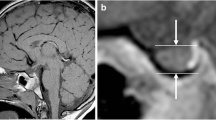Abstract
Background: Three-dimensional MRI (3D-MRI) is a reliable tool for the evaluation of anatomical volumes. Volumetric measurement of the normal anterior pituitary gland in childhood has been performed in the past by 2D-MRI calculations, but has inherent inaccuracies. Objective: To obtain accurate normal anterior pituitary gland volume in childhood using 3D-MRI coronal sections. Materials and methods: The anterior pituitary gland was measured using coronal T1-weighted 3D-gradient-echo sequences (section thickness 0.75 mm). The study group was composed of 95 prepubertal children (age range 2 months–10 years) with clinically normal pituitary function and no pituitary or brain abnormalities. Results: A measurement error of 0.2–0.4% was assessed by using a phantom study. Volumetric evaluation of the anterior pituitary gland showed progressive growth of the gland from a mean 131±24 mm3 at 2–12 months, to 249±25 mm3 at 1–4 years and 271±29 mm3 at 5–10 years. Conclusions: These data may be useful for paediatricians in the evaluation of patients with neuroendocrine diseases, in particular growth hormone deficiency.




Similar content being viewed by others
References
Maghnie M, Strigazzi C, Tinelli C, et al (1999) Growth hormone deficiency (GHD) of childhood onset: reassessment of GH status and evaluation of the predictive criteria for permanent GHD in young adults. J Clin Endocrinol Metab 84:1324–1328
Growth Hormone Research Society (GRS) (1998) Consensus guidelines for the diagnosis and treatment of adult with growth hormone deficiency: summary statement of the Growth Hormone Research Society workshop on adult growth hormone deficiency. J Clin Endocrinol Metab 83: 379–381
Maghnie M, Triulzi F, Larizza D, et al (1990) Hypothalamic-pituitary dwarfism: comparison between MR imaging and CT findings. Pediatr Radiol 20:229–235
Triulzi F, Scotti G, Di Natale B, et al (1994) Evidence of a congenital midline brain anomaly in pituitary dwarfs: a magnetic resonance imaging study in 101 patients. Pediatrics 93:409–416
Kornreich L, Horev G, Lazar L et al (1998) MR findings in growth hormone deficiency: correlation with severity of hypopituitarism. AJNR 19:1495–1499
Argyropoulou M, Perignon F, Brunelle F, et al (1991) Height of normal pituitary gland as a function of age evaluated by magnetic resonance imaging in children. Pediatr Radiol 21:247–249
Murray RA, Maheshwari HG, Russel EJ, et al (2000) Pituitary hypoplasia in patients with a mutation in the growth hormone-releasing hormone receptor gene. AJNR 21:685–689
Hamilton J, Blaser S, Daneman D (1998) MR imaging in idiopathic growth hormone deficiency. AJNR 19:1609–1615
Nagel B, Palmbach M, Petersen D, et al (1997) Magnetic resonance images of 91 children with different causes of short stature: pituitary size reflects growth hormone secretion. Eur J Pediatr 156:758–763
Peyster RG, Hoover ED, Viscarello RR, et al (1983) CT appearance of the adolescent and preadolescent pituitary gland. AJNR 4:411–414
Mc Lachlan MS, Williams ED, Fortt RW, et al (1968) Estimation of pituitary gland dimension from radiographs of the sella turcica. A post mortem study. Br J Radiol 41:323–330
Pikulev LA, Gerasimov SM, Cheremisin VM, et al (1970) Relationship between the volume of the hypophysis and the volume of the sella turcica (radioanatomic study). Arkh Anat Gistol Embryol 59:98–104
Sharafuddin MJ, Luisiri A, Garibaldi LR, et al (1994) MR imaging diagnosis of central precocious puberty: importance of changes in the shape and size of pituitary gland. AJR 162:1167–1173
Tsunoda A, Okuda O, Sato K (1997) MR height of the pituitary gland as a function of age and sex: especially physiological hypertrophy in adolescence and in climacterium. AJNR 18:551–554
Lurie SN, Doraiswamy PM, Husain MM, et al (1990) In vivo assessment of pituitary gland volume with magnetic resonance imaging: the effect of age. J Clin Endocrinol Metab 71:505–508
Wiener SN, Rzeszotarski MS, Droege RT, et al (1985) Measurement of pituitary gland height with MR imaging. AJNR 6:717–722
Doraiswamy PM, Potts JM, Axelson DA, et al (1992) MR assessment of pituitary gland morphology in healthy volunteers: age- and gender-related differences. AJNR 13:1295–1299
Oliveira HA, Salvatori R, Krauss MP, et al (2003) Magnetic resonance imaging study of pituitary morphology in subjects homozygous and heterozygous for a null mutation of the GHRH receptor gene. Eur J Endocrinol 148:427–432
Takano K, Utsunomiya H, Ono H, et al (1999) Normal development of the pituitary gland: assessment with three-dimensional MR volumetry. AJNR 20:312–315
Kucharczyk W (2000) Etiology of congenital growth hormone deficiency. AJNR 21:1000
Netchine I, Talon P, Dastot F, et al (1998) Extensive phenotypic analysis of a family with growth hormone (GH) deficiency caused by a mutation in the GH-realising hormone receptor gene. J Clin Endocrinol Metab 83:432–436
Maghnie M, Triulzi F, Larizza D, et al (1991) Hypothalamic-pituitary dysfunction in growth hormone-deficient patients with pituitary abnormalities. J Clin Endocrinol Metab 73:79–83
Hellstrom A, Wiklund LM, Svensson E, et al (1998) Midline brain lesions in children with hormone insufficiency indicate early prenatal damage. Acta Paediatr 87:528–536
Author information
Authors and Affiliations
Corresponding author
Rights and permissions
About this article
Cite this article
Marziali, S., Gaudiello, F., Bozzao, A. et al. Evaluation of anterior pituitary gland volume in childhood using three-dimensional MRI. Pediatr Radiol 34, 547–551 (2004). https://doi.org/10.1007/s00247-004-1208-6
Received:
Revised:
Accepted:
Published:
Issue Date:
DOI: https://doi.org/10.1007/s00247-004-1208-6




